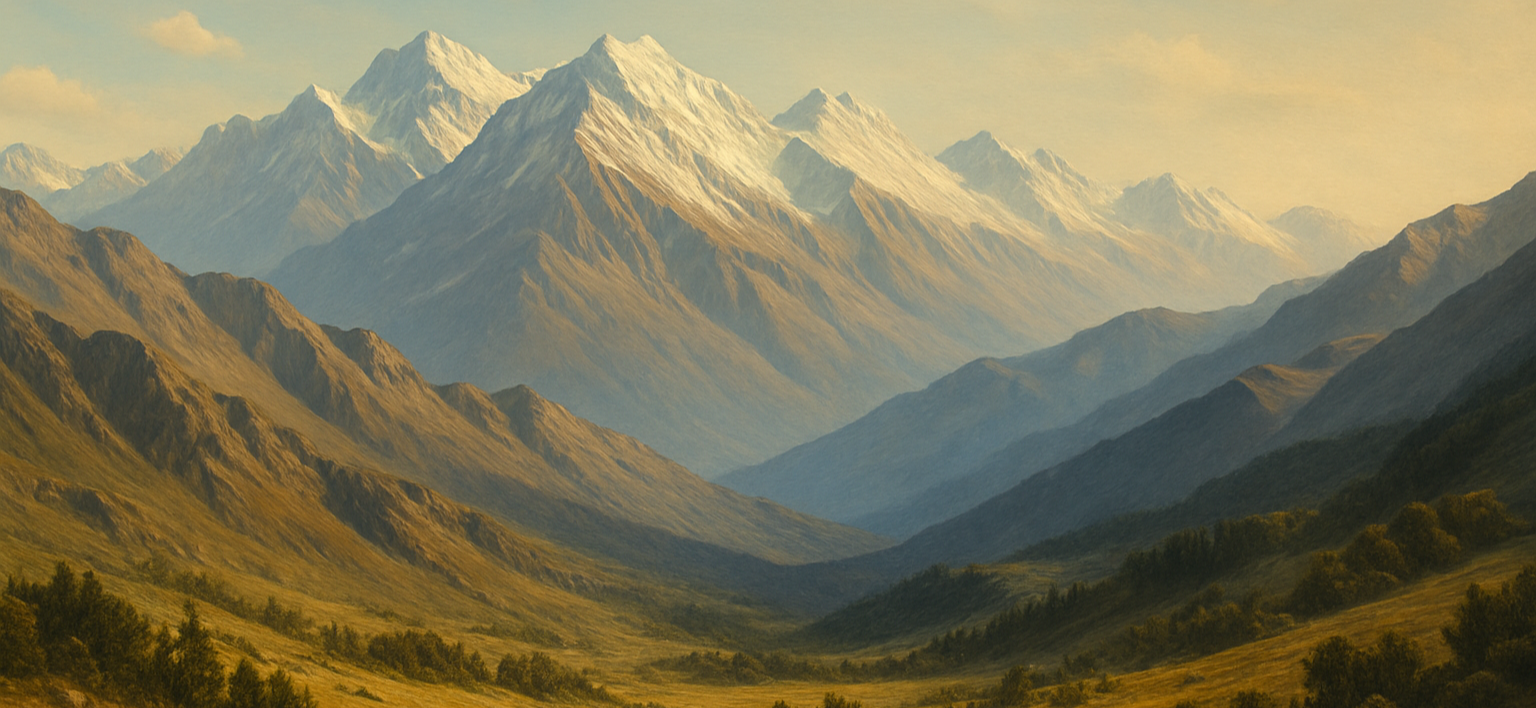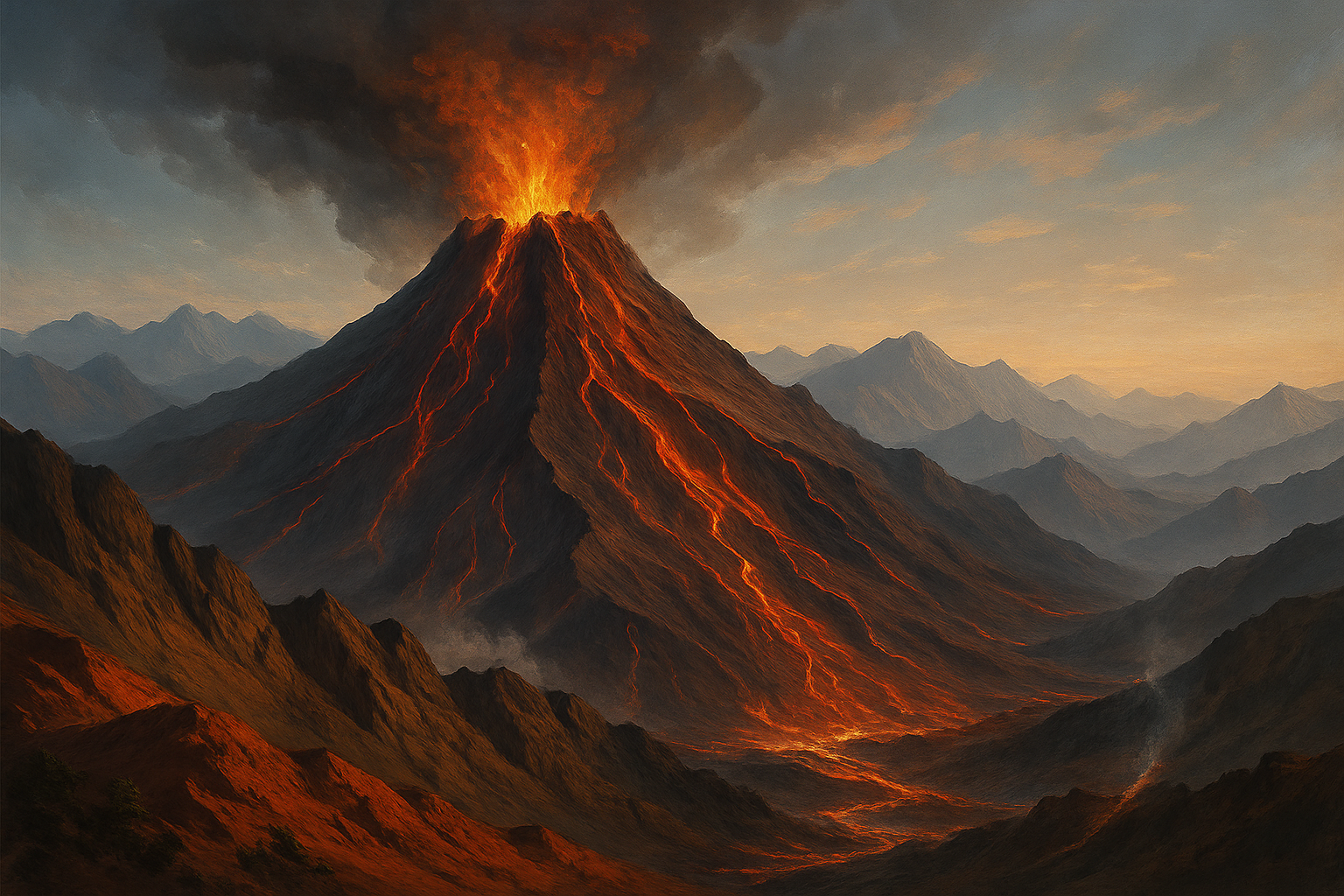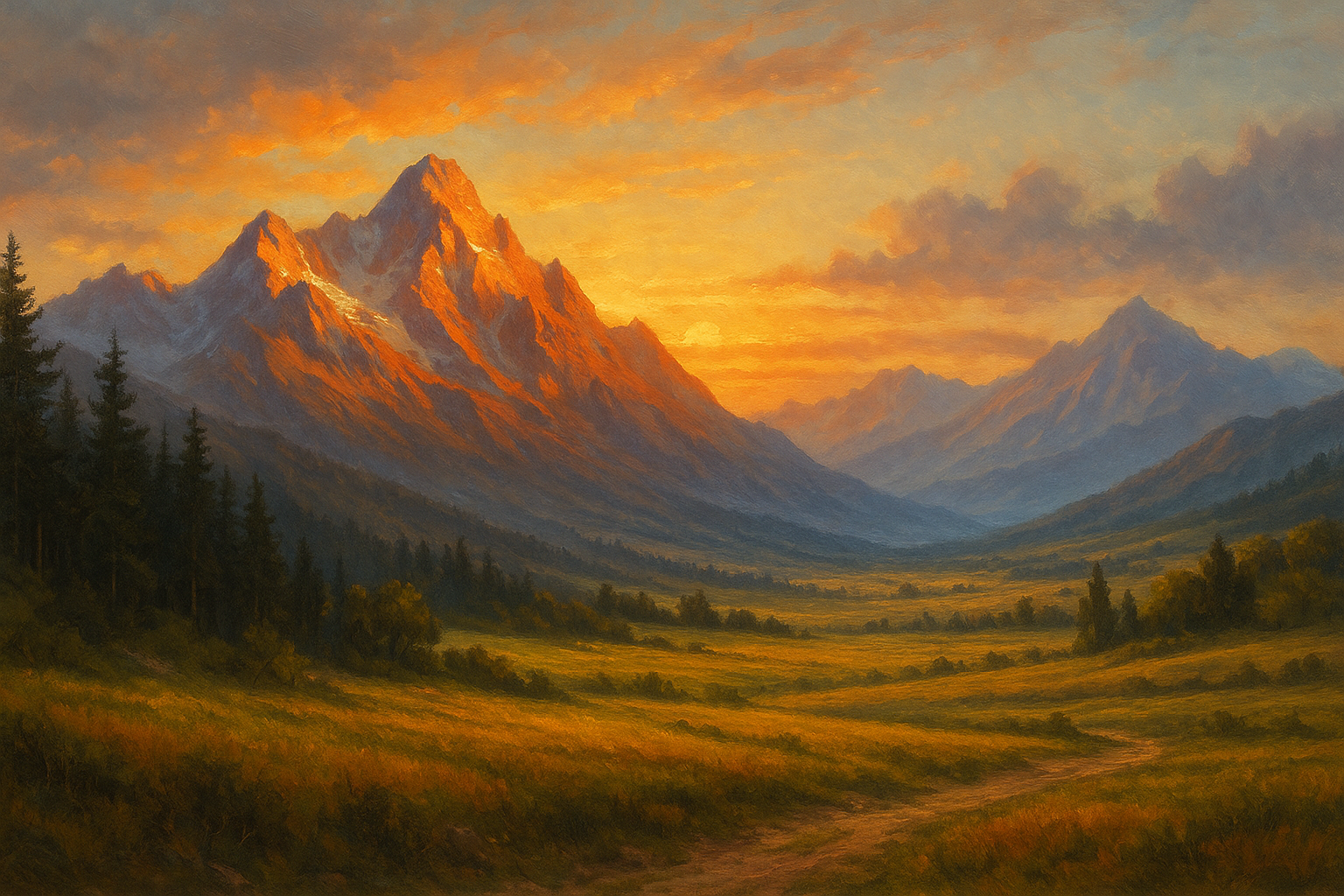Ashspire Mountains
The Ashspire Mountains form the fiery spine of Zalhara, a chain of jagged volcanic peaks that split the continent in two. Their smoldering ridges dominate the landscape, shaping weather patterns, cultures, and trade routes across the land. Known for constant geothermal activity and leyline surges, the Ashspires are both a natural barrier and a wellspring of magical power.
These mountains are alive with elemental forces—lava rivers carve paths through their slopes, ash clouds darken the skies during eruptions, and glowing crystals form in the deep caverns. To the people of Zalhara, the Ashspires are a place of both reverence and fear, a symbol of creation and destruction intertwined.
Geography
The Ashspire range stretches north to south, separating the fertile Western Heartlands from the arid Eastern Basin. Towering peaks pierce the clouds, some perpetually crowned with smoke. Narrow passes cut through the mountains, serving as treacherous trade routes that connect east and west. The lower slopes are rugged and rocky, while the upper reaches glow faintly at night from volcanic vents.
The region is dotted with lava tubes, crystal caverns, and ash plains where nothing grows except the hardiest flora. Earthquakes frequently reshape the terrain, and some valleys are littered with sharp obsidian shards left by ancient eruptions.
Western Central Slopes
The western side of the central Ashspire range is marked by towering, mist-wrapped peaks and verdant foothills. This region has steep ridges, terraced valleys, and lush vegetation clinging to rocky cliffs. Waterfalls cascade from high altitudes into clear rivers below, feeding the fertile lands to the west. This side is scenic but treacherous, with sharp elevation changes and unpredictable weather.Eastern Central Slopes
The eastern face of the same central stretch transitions into a harsher, arid environment. The rocky slopes here are sun-scorched, with sparse vegetation and a landscape scarred by wind erosion. These mountains descend abruptly into the Eastern Arid Basin, making the eastern slopes drier, dustier, and far less hospitable than their western counterpart. Here, the heat radiates off the stone, and leyline surges occasionally create mirage-like distortions in the air.Northeastern Volcanic Zone (Flameheart Crater)
This section of the Ashspires is dominated by volcanic activity. The Flameheart Crater—the second largest volcano in Tanaria—defines the geography with its blackened lava fields, glowing fissures, and rivers of cooled basalt. Ashfall drifts into the surrounding lowlands, and the ground trembles with occasional eruptions. Despite its danger, this zone is rich in ember crystals, obsidian, and other rare volcanic resources. It is both sacred and feared by those who live nearby.Southern Ashspires
The southern stretch of the range, while less severe than the central or northeastern regions, remains imposing. The mountains here rise in broad, snow-dusted ridges with wide valleys between them. The lower slopes are rocky and forested, while the upper peaks are harsh and cold. These southern mountains act as a natural barrier to the Frostmarch winds and contain hidden fortresses and ancient paths used by traders and warriors for centuries.Ecosystem
The Ashspire Mountains support a surprisingly diverse ecosystem due to their varying geography—ranging from lush western slopes to arid eastern cliffs and volcanic extremes in the northeast. Each section fosters unique lifeforms adapted to its conditions, with the range as a whole serving as a corridor where elemental forces and natural evolution intertwine.
Western Central Slopes
The western slopes, with their abundant rainfall and mist, support dense forests and vibrant wildlife.- Flora: Towering conifers, flowering shrubs, and moss carpets thrive in the cool, humid climate. Rare medicinal herbs grow near waterfalls, including moonpetal blossoms that glow faintly at night.
- Fauna: Mountain deer, shaggy goats, and agile cliff-cats roam the high ridges, while eagles and sky-serpents patrol the skies. The forests shelter black bears and elusive shadow-pumas revered by local clans.
- Magical Influence: Leyline-charged glades occasionally give rise to spirit foxes and other magical creatures tied to mist and water.
Eastern Central Slopes
The eastern slopes are drier, with scrub vegetation and creatures built for survival in heat and scarcity.- Flora: Thorned bushes, desert grasses, and drought-resistant flowering plants cling to cracks in the rocks. Ashvine creepers grow along canyon walls, their leaves storing water.
- Fauna: Herds of hardy mountain antelope and scaled lizards traverse the sun-baked ridges. Birds of prey, including the massive firecrest hawk, nest on cliff faces. Predatory rock-hounds, adapted to the arid terrain, stalk the foothills.
- Magical Influence: Mirage beasts—creatures that bend light around them—are rumored to roam here, blending into the arid backdrop.
Northeastern Volcanic Zone (Flameheart Crater)
This region is harsh and dominated by elemental fire. Vegetation is sparse, and much of the wildlife is tied to heat and magma.- Flora: Ember moss and heat-resistant brambles cling to cooled lava flows. Ashbloom flowers sprout briefly after eruptions, feeding on minerals in the volcanic soil.
- Fauna: Flame drakes, magma serpents, and ash-stalkers rule this area, their bodies adapted to heat and fire. Smaller creatures, like ember lizards, use volcanic vents to regulate body temperature.
- Magical Influence: Fire elementals and molten golems occasionally emerge from fissures, drawn by leyline surges tied to eruptions.
Southern Ashspires
The southern ridges mix alpine ecosystems with tundra-like conditions at higher altitudes.- Flora: Hardy pines, alpine flowers, and lichen dominate the upper slopes, while lower valleys host dense conifer forests.
- Fauna: Wolves, frost-stags, and snow leopards roam the cold ridges. Mountain-dwelling griffons are rumored to nest on the highest peaks.
- Magical Influence: Winter spirits and ice wraiths occasionally manifest during blizzards, haunting abandoned passes.
Natural Resources
The Ashspire Mountains are a treasure trove of minerals, magical materials, and rare flora, but their extraction is dangerous due to unstable terrain, leyline surges, and the creatures that guard these riches. Each section of the range offers distinct resources shaped by its environment.
Western Central Slopes
These lush, misty peaks are rich in organic and herbal resources as well as precious stones found in riverbeds.- Moonpetal Blossoms – A glowing flower prized for its healing properties and used in alchemical brews.
- Spiritwood – Timber from ancient trees infused with leyline energy, valued in crafting magical staffs and bows.
- Jade Crystals – Found in deep caverns, jade-like stones are highly prized in enchantments and ornamental work.
Eastern Central Slopes
The arid eastern highlands yield minerals and plants adapted to dryness, many with unique magical properties.- Ashvine Resin – A sap that hardens into a heat-resistant resin, used in armor coatings.
- Sunstone Ore – A bright mineral that stores solar energy, used in both jewelry and magical batteries.
- Copper and Iron Deposits – Easily mined where cliffs have eroded, supplying nearby settlements with metals.
Northeastern Volcanic Zone (Flameheart Crater)
The volcanic northeast holds the most dangerous but valuable resources in the range.- Ember Crystals – Fiery gemstones that radiate heat, essential for forging legendary weapons and powering arcane engines.
- Obsidian Shards – Razor-sharp volcanic glass, harvested for weapons and ritual tools.
- Volcanic Ash and Minerals – Fertilizer for exotic plants and key components in fire-resistant materials.
Southern Ashspires
The cold ridges of the south provide rare minerals and hardy natural materials.- Frostiron – A bluish steel-like ore that remains cold to the touch, resistant to heat-based damage.
- Snowmelt Crystals – Formed in frozen caves, these crystals hold pure elemental water energy.
- Alpine Herbs – Hardy medicinal plants used for stamina and frostbite remedies.






Comments